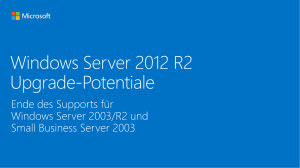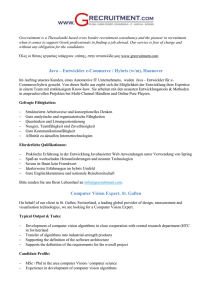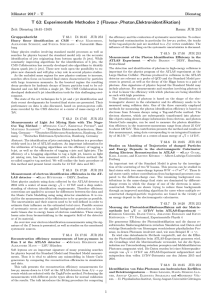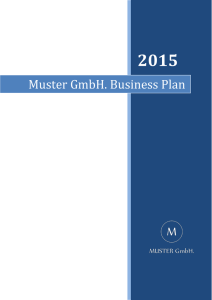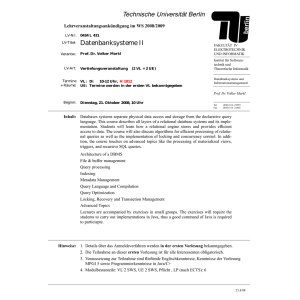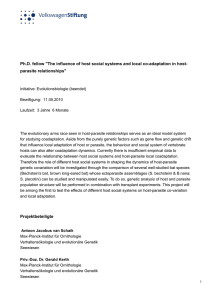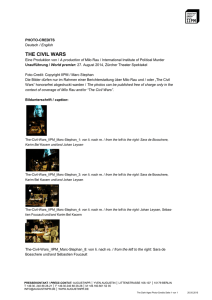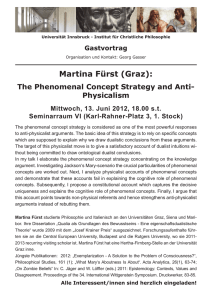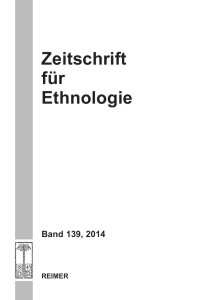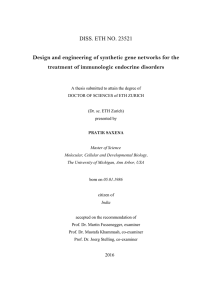DBT: Database Technology - dima.tu
Werbung
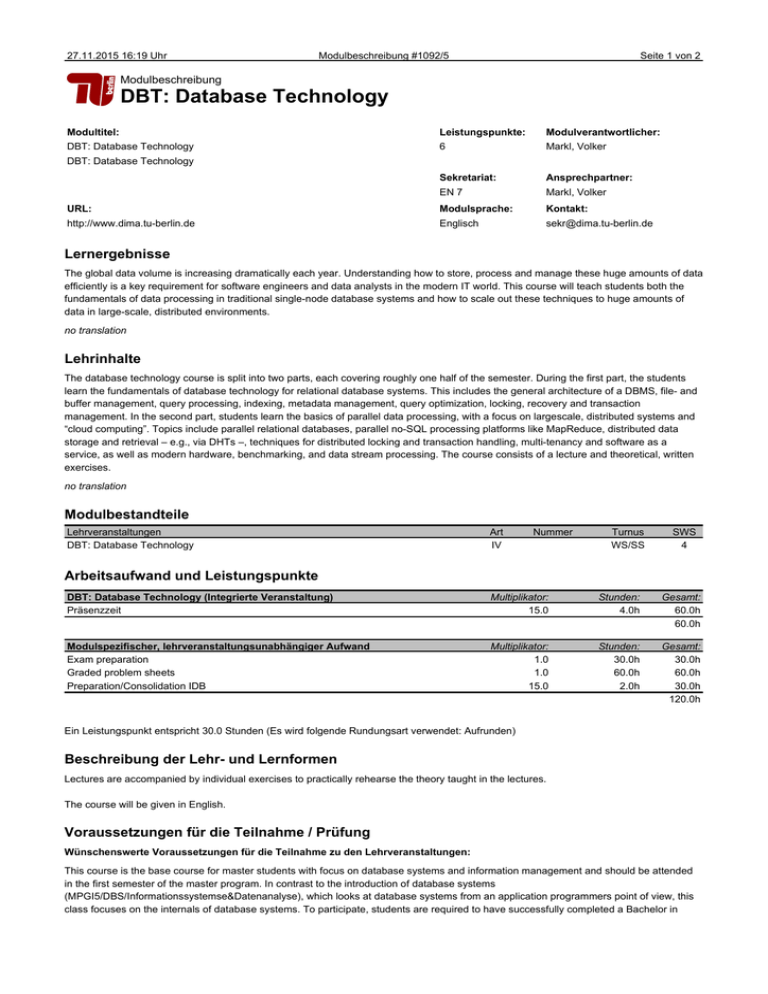
27.11.2015 16:19 Uhr Modulbeschreibung #1092/5 Seite 1 von 2 Modulbeschreibung DBT: Database Technology Modultitel: Leistungspunkte: Modulverantwortlicher: DBT: Database Technology 6 Markl, Volker Sekretariat: Ansprechpartner: EN 7 Markl, Volker URL: Modulsprache: Kontakt: http://www.dima.tu-berlin.de Englisch [email protected] DBT: Database Technology Lernergebnisse The global data volume is increasing dramatically each year. Understanding how to store, process and manage these huge amounts of data efficiently is a key requirement for software engineers and data analysts in the modern IT world. This course will teach students both the fundamentals of data processing in traditional single-node database systems and how to scale out these techniques to huge amounts of data in large-scale, distributed environments. no translation Lehrinhalte The database technology course is split into two parts, each covering roughly one half of the semester. During the first part, the students learn the fundamentals of database technology for relational database systems. This includes the general architecture of a DBMS, file- and buffer management, query processing, indexing, metadata management, query optimization, locking, recovery and transaction management. In the second part, students learn the basics of parallel data processing, with a focus on largescale, distributed systems and “cloud computing”. Topics include parallel relational databases, parallel no-SQL processing platforms like MapReduce, distributed data storage and retrieval – e.g., via DHTs –, techniques for distributed locking and transaction handling, multi-tenancy and software as a service, as well as modern hardware, benchmarking, and data stream processing. The course consists of a lecture and theoretical, written exercises. no translation Modulbestandteile Lehrveranstaltungen DBT: Database Technology Art IV Nummer Turnus WS/SS SWS 4 Arbeitsaufwand und Leistungspunkte DBT: Database Technology (Integrierte Veranstaltung) Präsenzzeit Multiplikator: 15.0 Stunden: 4.0h Gesamt: 60.0h 60.0h Modulspezifischer, lehrveranstaltungsunabhängiger Aufwand Exam preparation Graded problem sheets Preparation/Consolidation IDB Multiplikator: 1.0 1.0 15.0 Stunden: 30.0h 60.0h 2.0h Gesamt: 30.0h 60.0h 30.0h 120.0h Ein Leistungspunkt entspricht 30.0 Stunden (Es wird folgende Rundungsart verwendet: Aufrunden) Beschreibung der Lehr- und Lernformen Lectures are accompanied by individual exercises to practically rehearse the theory taught in the lectures. The course will be given in English. Voraussetzungen für die Teilnahme / Prüfung Wünschenswerte Voraussetzungen für die Teilnahme zu den Lehrveranstaltungen: This course is the base course for master students with focus on database systems and information management and should be attended in the first semester of the master program. In contrast to the introduction of database systems (MPGI5/DBS/Informationssystemse&Datenanalyse), which looks at database systems from an application programmers point of view, this class focuses on the internals of database systems. To participate, students are required to have successfully completed a Bachelor in 27.11.2015 16:19 Uhr Modulbeschreibung #1092/5 Seite 2 von 2 computer science with a focus on database systems (participation in the Datenbankpraktikum, Datenbankprojekt). Knowledge of data modeling, relational algebra, and SQL as well as a very good command of Java, or possibly C/C++/C#, programming is required to participate in the course. Due to capacity reasons, the class is limited to at most 60 participants. Verpflichtende Voraussetzungen für die Modulprüfungsanmeldung: keine Angabe Abschluss des Moduls Prüfungsform: Portfolioprüfung Benotet: benotet The final grade according to § 47 (2) AllgStuPO will be calculated with the faculty grading table 2. (Die Gesamtnote gemäß § 47 (2) AllgStuPO wird nach dem Notenschlüssel 2 der Fakultät IV ermittelt.) Prüfungselement (Deliverable assessment) Assessment of 4 homework exercises with 5 pts. (Examination) End term test (Examination) Mid term test Gewicht 20 40 40 Dauer des Moduls Das Modul kann in 1 Semester(n) abgeschlossen werden. Maximale teilnehmende Personen Das Modul ist auf 60 Teilnehmer begrenzt. Anmeldeformalitäten Students are required to register via the DIMA course registration tool before the start of the first lecture (http://www.dima.tu-berlin.de/). Within the first six weeks after commencement of the lecture, students will have to register for the course at QISPOS (university examination protocol tool) and ISIS (course organization tool) in addition to the registration at the DIMA course registration tool. Literaturhinweise, Skripte Skript in Papierform: nicht verfügbar Elektronisches Skript: nicht verfügbar Empfohlene Literatur: [1] Hector Garcia-Molina, Jeffrey D. Ullman, Jennifer Widom: Database Systems - The Complete Book, Pearson Education International, 2002. Or: [2] Garcia-Molina, Ullman, Widom: “Database Systems: The Complete Book,” Prentice Hall, 2000. [3] R. Elmasri und S.B. Navathe: Fundamentals of Database Systems, Benjamin Cummings Deutsche Übersetzung: “Grundlagen von Datenbanksystemen,“ Pearson, 2002. [4] J. Gray, A. Reuter: Transaction Processing, Morgan Kaufman, 1993. [5] T. Özsu und P. Valduriez: Principles of Distributed Database Systems, Prentice Hall, 1999. [6] Saake, Heuer, Sattler: “Datenbanken: Implementierungstechniken”, mitp Verlag, 2005 (2. Auflage). [7] Härder, Rahm: “Datenbanksysteme. Konzepte und Techniken der Implementierung,” Springer, 2. Auflage 2001. [8] Kemper, Eickler: “Datenbanksysteme – Eine Einführung,” Oldenburg, 5. Auflage 2004. Zugeordnete Studiengänge Die Modulversion wird auf keiner Modulliste verwendet. Sonstiges keine Angabe

